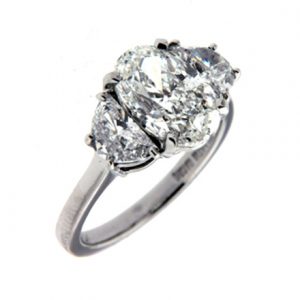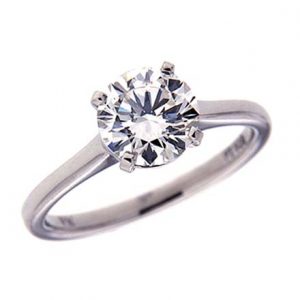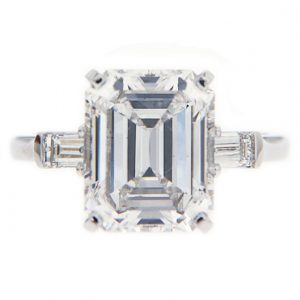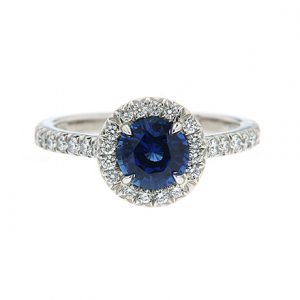Engagement rings are worn as a sign that its owner is planning to marry. They date back to the Roman Empire, when women who were to be married would wear gold rings in public and iron rings at home. As the centuries passed, the tradition of wearing a ring to signal impending marriage spread throughout Europe and the rest of the world.
One of the most famous engagement rings in history belonged to Mary of Burgundy. In 1477, her fiancé Archduke Maximilian of Austria gave her a diamond ring, using the hardness of the jewel to symbolize the strength of his love for her. Diamond engagement rings have been popular since. Diamond rings received another boost in 1947, the year DeBeers started its “A Diamond is Forever” campaign. More people than ever before learned about diamonds as a symbol of everlasting love. The majority of engagement rings today shine with diamonds.
Modern diamond engagement rings come in a near limitless amount of designs. There are solitaire rings, three stone diamond bands, diamond eternity bands and other styles which influence the number of diamonds of the ring. Embellishments can add yet more diamonds and shine, such as halos, side stones or pave sets. Some connoisseurs like their rings to have a vintage touch, like with white gold engagement rings, others want cutting edge styles or a touch of color in their engagement rings. Some guidelines and styles are listed below.
Diamonds and Engagement Rings
 It’s a common practice for people planning to marry to wear rings boasting one or more diamonds. Diamond engagement rings are full of symbolism and tradition, ranging from the cut and number of stones to the finger it’s worn upon. One detail regarding diamond engagement rings may be more utilitarian than romantic, but is essential to consider; the ring’s durability.
It’s a common practice for people planning to marry to wear rings boasting one or more diamonds. Diamond engagement rings are full of symbolism and tradition, ranging from the cut and number of stones to the finger it’s worn upon. One detail regarding diamond engagement rings may be more utilitarian than romantic, but is essential to consider; the ring’s durability.
Diamonds have been renowned for centuries for their supreme hardness. Only a diamond can scratch another diamond, making it an ideal gemstone for everyday wear, on a piece of jewelry subject to accidental bangs and blows. If paired with metal resistant to corrosion such as gold or platinum, diamond rings can last for lifetimes.
While diamonds are the hardest mineral on earth, they’re not invincible. Pear cut diamonds, marquise cut diamonds and other diamonds with narrow corners are prone to damage if hit the wrong way. Diamond engagement rings are also vulnerable to cuts and chips from other diamond jewelry if improperly stored.
To help keep your ring as beautiful as the day it was made, try to ensure that any corners are covered with special prongs. When storing your diamond ring, take care to prevent it from brushing against other jewelry. For extra security make sure your ring stays away from extreme temperatures and harsh chemicals.
Choosing an Engagement Ring
Diamond engagement rings are a symbol for a powerful love that promises to grow stronger. Many who own engagement rings wear theirs daily, sometimes continuing to wear it after marriage alongside their wedding band. Not only should a diamond engagement ring be a beautiful sign of a couple’s love, it should be in a style its owner is happy to see every day.
Diamonds’ unrivaled hardness make them able to withstand daily life, reflecting a bond that holds strong over outside forces and making them an ideal choice for engagement rings. Diamond cuts and ring styles have waxed and waned in popularity over centuries. At the same time, jewelers are constantly innovating, finding new ways to make diamonds and their mounts shine like never before.
Those who enjoy a classical look may want to consider a round brilliant cut diamond engagement ring. Solitaire diamond engagement rings on a plain band made their modern debut in 1886. Round brilliant cut diamonds are a popular choice for this style of ring as they maximize sparkle using only one jewel. People seeking an Edwardian or earlier style may choose cushion cut engagement rings, while those who enjoy geometric vintage looks would do well with emerald cut engagement rings.
Those looking for something more unusual have a wealth of designer engagement rings to choose from. In addition to newer cuts like the princess or radiant, there are side stones, pave and band embellishments in endless permutations. If one has trouble deciding what cut to have on their ring, they can compromise with a center stone of one shape and side stones of another.
Solitaire Diamond Rings
 With so many cuts, mounts, embellishments and other factors to consider, choosing the right diamond engagement ring can seem like a daunting task. There are ways to make a selection easier, such as consulting your beloved about their tastes, deciding on a firm budget, and asking jewelers which rings they recommend. One style that remains a classic is a single diamond mounted on a band, also known as a solitaire diamond ring.
With so many cuts, mounts, embellishments and other factors to consider, choosing the right diamond engagement ring can seem like a daunting task. There are ways to make a selection easier, such as consulting your beloved about their tastes, deciding on a firm budget, and asking jewelers which rings they recommend. One style that remains a classic is a single diamond mounted on a band, also known as a solitaire diamond ring.
If you choose a round brilliant cut diamond or other brilliant cut for your diamond engagement ring, specific mounts will help draw out the diamond’s shine. Prong mounts, which hold diamonds in place with thin wires, allow more light to enter a stone. Illusion settings help create the impression of a larger, brighter diamond by surrounding the stone with a rim of highly polished platinum or white gold. The precious metal acts as a mirror, reflecting more light to the viewer’s eye.
Diamonds are famed for their beauty and hardness. They are still prone to damage, especially around thinner areas like the girdle. To protect their jewels, some people choose settings like the bezel mount. The bezel set uses a rim of precious metal to surround the girdle, giving the jewel extra protection from accidental bumps.
While solitaire diamond rings have only one jewel, there is still room for embellishment. Depending on the designer, diamond rings may have scrolls or other flourishes engraved or embossed on the band. The shank may also be grooved, split, given a double shank or other embellishments. There are also polishes which influence the final shine of the precious metal, and finishes which add texture to the ring.
The Four Cs
The hardness of diamonds mounted on engagement rings symbolize the strength of the bond between a couple about to marry. Choosing the diamond that best represent your love is a big step. Quality matters, as does its beauty. The guidelines of cut, color, carat and clarity, also known as the 4Cs, will help you decide which diamond engagement ring is best for you.
Carat, a unit of weight denoting the size of a diamond may be one of the more apparent of the 4Cs. The heat and pressure needed to turn carbon into a gemstone also makes it difficult for larger diamonds to form. This rarity has the effect of making diamonds more desirable as they increase in size. With all other factors equal, a diamond engagement ring with a one carat diamond is more valuable than one with two half carat diamonds.
Color indirectly notes the trace elements within a diamond. About 98 percent of diamonds contain minute amounts of nitrogen, giving them tints of yellow or brown. The fainter the color, the more in demand the diamond bands. The differences in color may be very subtle to an untrained eye, though gemology labs have the equipment and expertise to tell the difference. The Gemological institute of America (GIA) uses a grading system which runs from D to Z, with D being completely colorless and Z having the strongest brown or yellow tinge.
Clarity measures the amount and types of imperfections on and inside a diamond. These quirks may range from polish lines or an extra facet on the finished stone, to other crystals trapped within the diamond or a microscopic cloud. GIA measures diamond clarity from a scale ranging from Flawless to Included 3. The fewer clarity characteristics within a stone, the rarer it is. Jewelers may see only one Flawless grade diamond in a lifetime. Many connoisseurs aim for diamond bands with as few clarity characteristics as possible. Others have a soft spot for diamond engagement rings unique inclusions, such as a cloud in the shape of a heart.
Cut is a characteristic directly influenced by human hands. People rarely buy jewelry which feature diamonds in their natural states. How a diamond is cut influences its brilliance, durability and shape. There are many types of diamond cuts, those which highlight clarity and luster, others that reflect great quantities of light, and those with whimsical forms. While most have individual criteria as to what makes a quality cut, all diamonds on engagement rings should adhere to symmetry, polish and even facets.
The four Cs of carat, color, clarity and cut are a universal language by which to determine a diamond’s quality. Knowing what they are and understanding their rating scales will help in selecting the right jewel for your diamond engagement ring. While some categories of the 4Cs may be more apparent than others, in the end it is up to you to determine what traits you want in your diamond engagement ring.
Brilliant Cuts
The round brilliant cut diamond is one of the most popular choices for diamond bands in the world. It’s best known for its ability to take in and reflect white light, as well as splitting white light into the various hues of the rainbow. Round brilliants and similar cuts adhere to careful standards or symmetry, proportion, depth and other qualities in order to reflect an optimal amount of light. Ideally, light enters the top facet, reflects from inner facets and exits through the facet from which it came.
There are three types of light brilliant cuts diamond engagement rings are best known for. These diamond bands should have a balance of brilliance, fire and scintillation. Brilliance denotes the white light that enters a diamond and is reflected from its internal facets. Fire is the white light that is split into prismatic hues, and manifests as flashes of color amongst the brilliance. Scintillation is the balance of white light and shadow.
While diamond cutters spent centuries finding a way to brighten the diamonds on engagement rings, a 1919 academic paper introduced the round brilliant cut as a way to create optimal light return. Jewelers continue to find ways to improve on how bright a diamond can be. Other diamond engagement rings have cuts with fancy shapes like the marquise, pear and heart cuts.
Some gemstones combine carat preserving qualities with the light shows of brilliant cut diamonds. These styles are known as mixed cuts. They are usually square or rectangular, with lower facets like those of a brilliant cut and upper facets closer to a step cut. Popular mixed cuts include princess and radiant cuts for engagement rings.
Step Cuts
 Some types of diamond cuts are designed to highlight the luster, or surface shine of a gemstone as well as to showcase its clarity. These style of cuts are often square or rectangular in shape, with parallel facets. Sets of facets are arranged in a concentric fashion, reminiscent of stairs, or steps. Such cuts are referred to as step cuts and feature in early 20th century and modern diamond engagement rings.
Some types of diamond cuts are designed to highlight the luster, or surface shine of a gemstone as well as to showcase its clarity. These style of cuts are often square or rectangular in shape, with parallel facets. Sets of facets are arranged in a concentric fashion, reminiscent of stairs, or steps. Such cuts are referred to as step cuts and feature in early 20th century and modern diamond engagement rings.
One of the most famous step cuts is the emerald cut, originally developed as a way to facet emeralds while putting the least amount of strain on the colored gemstone. The emerald cut eventually was used on diamonds as a way to highlight the interior of the stone. Other step cuts include the Asscher cut and the baguette. The former is a square shape with cropped corners developed in 1902 by the Royal Asscher diamond company. Baguette cuts are skinny rectangles often used to highlight larger diamonds on engagement rings.
When choosing a step cut stone for you diamond engagement ring, keep clarity in mind. With so much of the diamond’s interior on display, clarity characteristics become more apparent. Choosing a diamond with a high clarity grade is recommended. A stone with unusual clarity characteristics may also do well in a step cut diamond engagement ring.
Side Stones
One way of adding brilliance to diamond engagement rings is through additional diamonds. Side stones, or two or more smaller diamonds flanking a larger jewel, is a popular way to achieve extra sparkle. Diamond stones may be further embellished through halos or other means to make the brightest possible diamond engagement ring.
There is no fixed cut or shape for side stones. Brilliant, step and mixed all work well in highlighting the central stone engagement rings. Tastes may lean towards side and central stones that fit close together, like square side stones flanking a rectangular central diamond. Others contrasting shape, pairing square with round, or oval with pear cut diamonds. Usually two stones are used to highlight the center diamond, though some designs may use more jewels, like a five stone diamond engagement ring.
Popular cuts for side stones include round brilliants, pears and baguettes. Round brilliants are admired for their sparkle and are used in a plethora designs. Pears are often mounted lengthwise on the band, with their points facing away from the central stone. Baguettes add their luster and clarity to a diamond engagement ring. They may be mounted lengthwise along the band or perpendicular to it.

Colored Gemstones
Diamonds are the most popular gemstone for engagement rings. Their brilliance is renowned, and they enjoy centuries of tradition and symbolism concerning engagements and weddings. However, there are still people who want to wear something besides the classic diamond engagement ring. They may want to consider adding colored gemstones to their diamond engagement rings.
Colored gemstones, when used in engagement rings, often serve as accents to diamonds. Smaller stones may be used to surround a larger diamond, or flank the diamond as side stones. Other designs may have a colored gemstone as the central jewel, its hues offsetting the diamonds that decorate the rest of the ring.
When selecting colored gemstones for your diamond engagement ring, keep durability in mind. Engagement rings are meant to be worn on a high traffic part of the body, and may put more fragile gemstones at risk for accidental damage. It might be best to select gemstones with high Mohs hardness ratings like topaz or sapphires. If the stone is vulnerable to cracking from sharp blows, look for a mount, such as the bezel setting, that protects the jewels.
Halos
Halos aren’t a specific ring type, but a decorative element popular with diamond engagement rings. Where there is a larger jewel, a border of many tiny diamonds may be used to highlight the stone. The size of the jewels may resemble pave settings, but the latter is used to encrust parts of the bands of diamond rings while halos are used for edging. Halos are usually held in place with miniscule wires or beads, so as not to distract from their shine.
The most common form of halo is a single row surrounding a larger stone on diamond engagement rings. Miniature round brilliants are often used to make halos. Some variations turn to baguettes or other step cut diamonds for geometric style. While diamonds are most common, colored gemstones may be utilized to add visual interest.
Other ways to make a halo stand out include using a double row to add even more brilliance to the main diamond. If the ring has more than one larger diamond in it, like a three stone diamond engagement ring, the fiancé may choose to have all three individually wrapped in halos, or decide to have only the perimeter brightened. One may add brilliant cut halos to a step cut diamond or a baguette halo around a square brilliant cut for a study in contrast.





